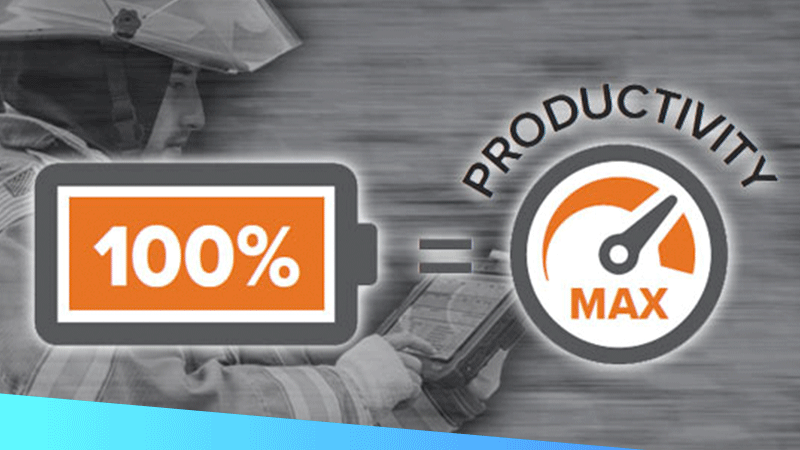
Do Not Get Caught Off-Guard, or Offline: Have a (Battery) Back-Up Plan
Editor's Note: This post was originally published May 3, 2019. It was most recently updated September 8, 2023, with feedback from Brad Willard, Manager, Product Safety & Test, Engineering Shared Services, Zebra.
###
There are many reasons why mobile workers could be knocked offline for extensive periods of time. Particularly if they are trying to use a mobile device that was never intended to be used for the job at hand. For example, a recent study conducted by WBR Digital and commissioned by NetMotion found connectivity issues are plaguing companies of all sizes. Poorly-placed antennas and lower-end communications technologies used in consumer-grade tablets, and even some rugged devices, are causing a lot of worker disconnects and even more help desk tickets.
But, there’s another common reason why workers are forced to power down and revert to paper-based processes: batteries. Specifically, mobile tech buyers’ misperception that batteries are meant to last “forever.” Although a study conducted by VDC Research found that battery life is a leading mobile devices selection criterion for 40% of enterprise decision makers, the truth is, batteries are consumables. In general, lithium ion batteries are good for approximately 500 charge cycles. There are many factors that will affect the lifespan, including whether the batteries are exposed to extreme temperatures, such as being left in a parked vehicle. This means the device using the battery will, or should, outlive the life of the battery. This is especially true in the case of quality rugged tablets built to stay in the field for three, five, even seven-plus years without issue.
Not replacing batteries on a regular basis exposes the device and user to potential harm. It also reduces the performance of the device – and worker productivity. As VDC revealed in its 2019 study, mid-shift battery failure, which respondents claim occurs at least 30% of the time, causes workers to lose 50 minutes of productivity. “Enterprises in retail and logistics with 500 or more mobile workers can suffer resulting productivity and service losses valued in the millions of dollars,” VDC reports.
Even batteries built to stay in service continuously for more than 24 hours will eventually need recharging. Some workers may be in the habit of recharging every chance they get, long before it is completely drained. Others wait until the battery is completely dead, then charge back to 100% hoping to stretch the battery another few shifts. The former can help prolong the battery’s life (as long as they aren’t fast charging every time). The latter can reduce the battery’s overall lifespan, which isn’t something most people know.
That means you should always adopt good battery charging practices and have a battery back-up plan in place. It is critical to the livelihood of your business because batteries are critical to your workers productivity. They should never, ever, be forced offline due to faulty batteries or, worse, old or degraded batteries. Therefore, your back-up plan should be two-fold:
1. Determine how your workers will recharge their devices on a daily basis. Many of your mobile workers are bouncing around from one job site to the other and spending hours on foot outside the four walls. Translation: they may be working far away from a brick-and-mortar facility or in-vehicle charging outlet and therefore require a field-replacement plan. In these cases, you should invest in a device that has a long-lasting battery. If this isn’t possible, it is important to invest in a second battery for every device bought so that workers feel comfortable pulling their primary battery out of service for recharging before it completely drains. Giving them devices with hot swappable or even warm swappable batteries minimizes disruptions to their workday by allowing for a quick battery exchange. They can recharge the primary battery while they keep working then make the swap again when needed – either later that day or the next day. Hot-swappable batteries are best because they do not require workers to power down to put in a fresh battery, which causes reboot delays every time. Time is money.
2. It is important to decide how your company will manage battery replacements. When a battery no longer supports a full shift or it's state of health drops to around 80%, it is time to replace it.. The catch is that you cannot afford to spin through a new (and long) battery procurement cycle every time another worker submits a helpdesk ticket for this predictable issue. Instead of waiting for the batteries to go bad, invest in an “insurance” policy upfront. Much like you would buy a maintenance and service plan for your car at the time of purchase. You know that you will need an oil change and tire rotation every 5,000 miles, and you know that the “aftermarket” price for the services will increase at regular intervals in time. You may pay $30 for the regular maintenance visit now, but $50 in two years from now. So, pre-paying for a protection plan, and locking in today’s rates, just makes sense. Plus, this type of plan gives you peace of mind that your vehicle will always be running at peak performance levels, which only extends the life of the vehicle.
The same goes for mobile device batteries. You know they are going to need be replaced every year and that aftermarket prices are typically steeper than “pre-purchasing” the batteries at today’s prices. The VDC report confirmed that 80% of mobile device total cost of ownership (TCO) comes after the initial purchase, with replacement batteries making up a significant portion of this cost. Why not add on a battery warranty protection plan for a few dollars when you buy the device? You will save more than a few dollars over the life of the device – which you are now extending, by the way, by keeping the batteries fresh. You’ll also save time and money that would otherwise be wasted on the exorbitant number of resources it takes to procure batteries in a rush (finance, IT, purchasing, etc.), while revenue-generating workers are offline and at a standstill.
As you look to invest in a battery protection plan, here are a few things to keep in mind when evaluating your options:
- How long will the coverage last, and how many replacement batteries will you be eligible to receive in that time frame? What happens if you need more?
- How long do you have to add-on the protection plan after you purchase the device?
- What discounts will you receive by buying the back-up batteries early? (i.e. at the time of device purchase)
- Does the protection plan price include shipping? Are there any other associated fees?
- What will you/your workers need to do to request the battery once needed? What information will we need to provide to confirm our eligibility in the program and/or confirm that the battery is indeed below acceptable capacity levels? These are important questions to ask upfront, though most people forget to do so. Note: It should be easy to initiate a request. For example, a worker should be able to call into a program hotline and place the request directly. The warranty provider should also be able to confirm eligibility using just the device’s serial number and verify battery performance via a handful of simple questions that your workers can answer without issue.
- How long will it take to receive the battery once program eligibility is confirmed? Remember, you’re spending money on these programs to defend against battery-related downtime. If it is going to take two weeks to receive the battery and the device is barely staying on now when it is not plugged in, that is not going to be helpful.
Battery performance is essential to device and worker performance. That is why you should make plans to purchase new batteries for rugged tablets that are over a year old. This will ensure you are maximizing the performance and life of your tablet, while reducing the chance for damage or harm from a battery that has passed its typical lifespan – both of which help you maximize your device investment.
Did you know?
Zebra offers Battery Management solutions, including a Battery Maintenance Service, to customers via Zebra OneCare®. Learn how this unique Support offering can help ensure continuous power for your mobile workforce to help eliminate unnecessary disruptions to workflows and productivity.

Tom McNeela
Tom McNeela brings over 25 years of experience in mobile technologies and solutions to Zebra. His experience covers a diverse range of both consumer and enterprise product offerings. In his current role, Mr. McNeela is responsible for managing the Enterprise Tablet portfolio within Zebra’s Enterprise Mobile Computing business. This includes understanding business and technology trends in the market, capturing the voice of the customer and understanding user profiles and business optimization strategies. Mr. McNeela utilizes these insights to define and maintain the Zebra Enterprise Tablet solution roadmap. He also works with key internal and external go-to-market partners and critical technology providers to execute against the roadmap.
Prior to joining Zebra, Mr. McNeela held roles in operations, development, engineering and program management. He travels internationally in support of customers and partners and has lived internationally as well. He holds a BS from the Illinois Institute of Technology, a MS from the University of Illinois and an MBA from Kellogg School of Management. He resides in Chicago and has three growing children that keep him busy and entertained.




